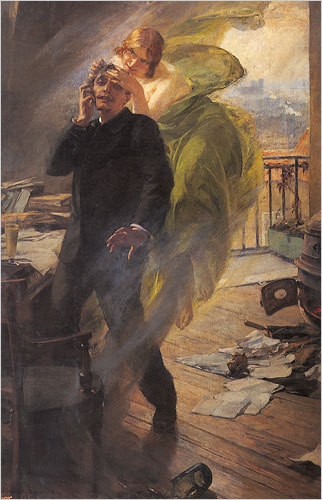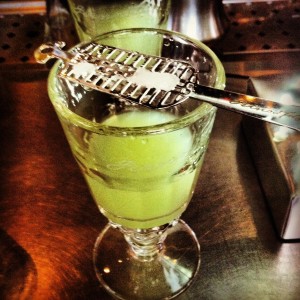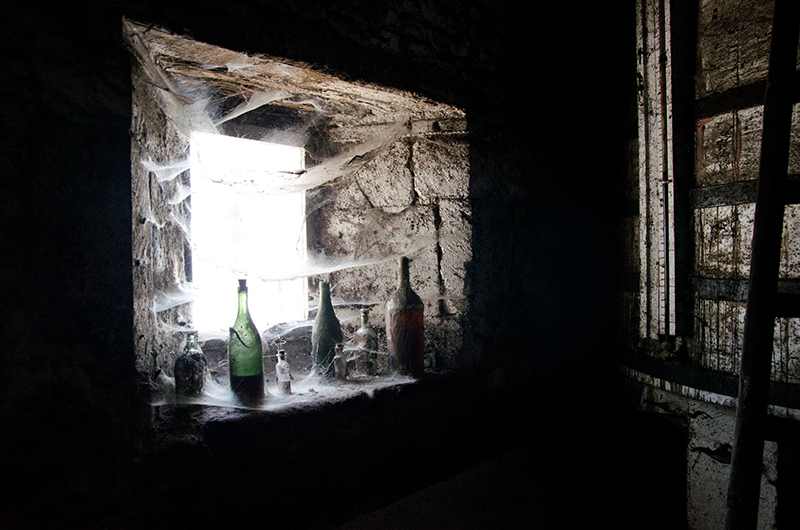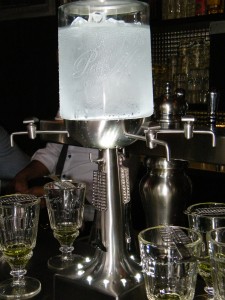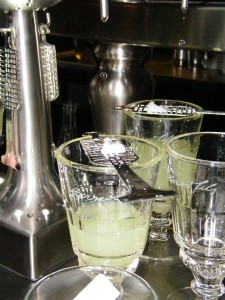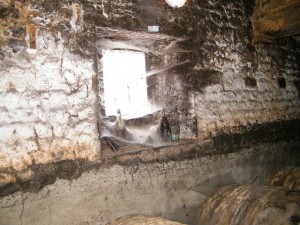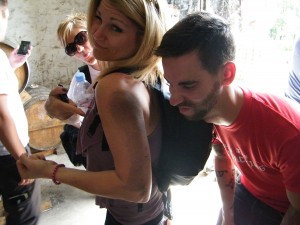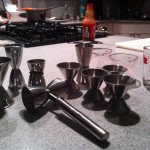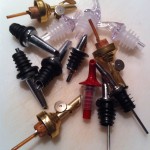To Jig or Not to Jig?
By Dante LoPresti
To jig or not to jig? That is the question.
In the short 3 years I have been a bartender, with all of its issues–strange hours, relationship woes, the great capacity for self destructive behavior–one tiny device is the cause of the biggest question I have encountered. There are things that bug me about this relatively new world I’ve been living in. I have many questions, big questions. Is this career I’ve chosen sustainable?
Back in 2004 when I graduated college, I began a career in residential real estate in Phoenix, AZ. Everyone was drunk on what I like to call “the juice”. They were teaching that the real estate values historically have always been on the incline and that there was no end in sight. Everyone was getting their real estate license. Everyone became an investor, and banks were giving money away to everyone. Then around 2006, people started saying, “uh oh. This is not sustainable”. And it wasn’t; the party was over. Now we are left with the proverbial hangover.
This could be personal speculation and based on good ol’ common sense, but I wonder, is the same thing true of our industry? I hear people say all the time that our industry stays strong despite economic conditions, basically that it will never fail. As the economy has worsened, the migration of college educated, late 20, early 30 somethings into the bartending profession is astounding. Simultaneously, restaurants and bars keep opening despite the moanings of a collapsing economy, and I ask myself once again, is this sustainable?
At this point, you may be asking yourself, what does a bad economy have to do with a tiny tin object? Simply, based on my experience over the last few years and conversations with bartenders from all over the country, I can say without much doubt in my mind that the cocktail renaissance, while it has flourished, has grown in some ways that alienates the very people it claims to serve. The biggest criticism is that it takes too long to get a cocktail, or that cocktail lists are unapproachable, and many times, that the bartender himself is equally as aloof. If this continues, at some point the well will go dry, and cocktail bars will become irrelevant or obscure.
As of now, the pendulum is still swinging in our favor. Our drinking culture is still coming out of the dark ages. The age of bottled sour mix, blue drinks, bastardized cocktail recipes–all things that at the core, were designed to make a bartenders job easier, faster, and more profitable–is being called into question. In 2011, we craft bartenders are at the helm of the cocktail enlightenment. People everywhere are waking up and demanding quality behind the bar. Bartenders are educated once again, and now they are in turn, educating the masses. People are listening! The bartender is restored to a position of reverence that it once deserved. They are juicing fresh, they are making syrups in house, they are involved in procuring the best made spirits on the market–every possible action to take control and improve the cocktail to it’s original glory is being taken. It’s beautiful. Sometimes, it is awe inspiring, but once again, there is a great danger. The devil is in the details, and in this case, it doesn’t mean what you think it means. It means that the devil is the detail.
And so, this brings me to the jigger. “So much depends upon a red wheelbarrow” says poet, William Carlos Williams. And so I say,
So much depends
upon
the stainless steel
jigger
glazed with tap
water
beside the boston
shakers.
The jigger. The symbol of balance. All the world seems to rest on this one tiny tool. Every drink is now measured. Consistency and quality are king. Order is once restored to a chaotic world full of free pouring and a total lack of regard to accuracy, right? Two plus years of bartending with a jigger screams a resounding “yes!” I was taught never to make a drink without it, and I have even trained other bartenders and consulted on the opening of two bars and taught with religious-like zeal that the jigger was never to be abandoned. Highball? Sure free pour, but if it’s a “real” cocktail, it deserves the courtesy of being measured everytime, without fail.
However, at some point in my journey, my reasoning began to crack. If there was ever a free pour contest during a slow bar shift, I lit up. If there was a speed competition, I was like a little kid again watching the big kids play. I wanted to be accurate as a Samurai warrior, and fast like a Ninja behind the bar. The prospect of performing like an athlete behind the bar excited me, but it never reconciled with the craft bartending world. I treated them like two separate planes, never touching each other–parallel existences. But as I grew up as a bartender, I started to see things that didn’t make sense. I saw older, talented bartenders free pouring–Dale DeGroff, for example. I also heard the grumblings of other talented bartenders scoffing at the jigger like it was some kind of insult. Though, the big turning point for me was this year at Tales of the Cocktail in New Orleans. There was an event called “Rematch”, where bartenders from all around the country, talented ones, were competing for who could make 10 craft cocktails in the shortest amount of time. Some were inexperienced, taking longer than the allotted time, and others blazed through the exercise like Vishnu, the Hindu supreme deity. Not only that, many of them used “working” flair. I was in awe. These guys were masters behind the bar. Still, I didn’t taste their drinks, so I wasn’t convinced, but I was open to the idea that a barman didn’t need to measure every pour with a jigger.
Two plus years in, working in a high volume craft cocktail bar, banging away at jiggering every single cocktail, training other bartenders to do the same, I find myself questioning the whole craft cocktail movement. I love it. I’m passionate about it, but at the same time I have never felt more inclined to go work at a night club. I have found time and time again that I could often make the same tip making a vodka soda, versus a seven ingredient cocktail shaken with Kold Draft ice cubes. That alone hasn’t deterred me though. I’m passionate about well thought out, well executed craft cocktail, but at what cost? At what point does quality have to submit to economic viability? Though it’s completely subjective, for me, I’m not getting any younger, and my bank account isn’t getting much bigger. Something has to give. There has to be a way to make quality cocktails faster and more efficiently, but how? The craft cocktail movement and the speed bartending movement, or whatever it’s called, are diametrically opposed. Aren’t they?
October 5, 2011, Chicago, Illinois, Advanced Culinary Mixology Academy. It’s the very last class of the series, “Zen Bartending.” Twenty some bartenders–mostly all “mixologist” types–jigger worshippers. Wink, wink.
Enter Tobin Ellis, barman extraordinaire. The man has done everything behind the bar that I have done 10 times over and then some. He’s seen the pendulum shift from the excesses of flair bartending to the numbing temperance of technical bartending. I have to admit that I haven’t gotten this pumped up since my first class with Bridget Albert’s Academy of Spirits when we made a whisky sour using bottled sour mix versus fresh sour. It’s not very often that your whole paradigm of thinking completely shifts. These are days to be remembered.
I was so excited for this class. Throughout my journey as a bartender, I’ve hungered for a seminar like this. Lately, I’ve felt heavy on the expository side of the business–history, production methods of spirits, and all the things that we craft bartenders tend to “geek” out over. For years, I was dissecting and explicating everything behind the bar, but only superficially exploring service philosophy and technique. And though I thought myself a savvy bartender, I never put a big emphasis on refining those skills. Most of what I learned technique-wise, was learned by watching other more seasoned bartenders, reading some articles, or my own trial and error. The idea of covering these almost secretive subjects all in one day was almost too much. As it turned out it was! We only made it halfway through all the subject matter. Honestly, we could have filled an entire semester with what we intended to cover that day.
And so it began. Not far out of the gate once class began, Tobin admitted how excited he was to take on 20+ mixology oriented bartenders. We began with pouring methods. Kids stuff. We’d all poured almost everyday of our bartending lives, yet, these simple techniques proved challenging for us all. We were spilling everywhere!
“All drops are gold,” he said.
I’d never realized how little attention I had paid to all the tiny drops that I had spilled behind the bar. I remember fleeting moments where I justified the tiny drops lost between shot glasses as “angels share.” Never again.
Next we covered counting our pours–a method I had learned during my first bartending job–long before the sacred jigger ever entered my life. However, this time, there was proper instruction and accountability measures involved. Not only that, we were testing our jigger pours against our free pours, and much to our surprise, our jigger pours were highly inaccurate compared to our free pours.
The lightbulb.
I realized that since my jiggering days began, I had never stopped counting in my mind while I poured drinks. Here I was, all this time, perfecting my counting accuracy with the help of the jigger. It was as if I learned how to ride a bike years ago, but never trusted enough to take the training wheels off. Not only that, there wasn’t anyone telling me I could! I wasn’t upset. I knew that just moments ago, most of us were having the same epiphany.
Next, we were confronted with a wonderful freedom. The hand that held the jigger was now empty! What do you with it? All of a sudden the world was round, and the earth revolved around the sun, and it was unsettling. We were all trying to reconcile ourselves to this newfound freedom. It was horrifying, and at the same time, it was absolutely comical. We were trying things we had never tried before–pouring two, three bottles at once! We were thinking about what came next, like a chess game–the shortest amount of moves to beat your opponent, the clock. I have to admit at that point not all of us were good at being accurate. Some of us got carried away, though some of us were more cautious, but given some time and training, we could be perfect our skill. By the end of class, I was thirsting for more. A couple of times during class Tobin had to reign me in. It was like back in those days as a kid playing basketball when I realized I could sink a three pointer. I would’ve stayed until they shut the lights off.
The Conclusion of the matter. Jiggering:
The Pros:
1. Jiggering is great learning tool. I think it is essential for bartenders who are training.
2. In the absence of fast pours, the jigger is very useful.
3. Allowing that the bartenders at a bar are all using the same jigger, it does provide relative consistency across the board.
4. In certain bars, the jigger does carry a certain amount of comfort to the guest that they are receiving a well crafted cocktail.
The Cons:
1. Jiggering drinks is highly inefficient. Not using a jigger could improve speed up to at least 50 percent.
2. Jiggering, though ensuring relative consistency, is still highly inaccurate.
3. Jiggers are not created equal.
4. Bartenders rarely pour accurately into a jigger.
5. In some applications, jiggering is seen as cheap to the customer.
The Pros carry some weight, but in my opinion, the applications for using a jigger are temporary or isolated at best. Though there is always the question of accuracy with free pouring, the jigger offers no better results, if not worse. In conclusion, my belief is that a well trained, practiced bartenders pour is far more accurate and efficient.
From a profitability perspective, if a bartender can be potentially 100 percent more productive without a jigger, there isn’t room for question. The point is moot. And with regards to sustainability of a business, craft cocktail bars really need to step back and take a good look at themselves. With a shaky world economy, the first bars to fold will be those that are less profitable. Let’s not forget, we haven’t even addressed the issue that most of the population is either ignorant or ambivalent toward craft cocktails, and in some instances, hostile. The “mixologist” has developed a reputation of pretension among some that is highly detrimental to its survival. I highly doubt that those establishments will survive for very long. The bar of the future is one that embraces the highest quality service possible with respect to a sustainable, profitable business model. To jig or not to jig? I say no!
The question remains for you then: to jig or not to jig?
Perhaps Hamlet’s famous soliloquy will be of help to you.
“To be, or not to be: that is the question:
Whether ’tis nobler in the mind to suffer,
The slings and arrows of outrageous fortune,
Or to take arms against a sea of troubles,
And by opposing end them? To die: to sleep;
No more…”
Are we to suffer with the jigger, or should we just end the suffering, and take on the mysterious world of free pouring? Thankfully, the question is not so gravely serious as Hamlet’s but it serves as a great metaphor. For me, the bar that I will be working at will probable never endorse my willingness to take arms against my sea of troubles. For now, I will have to suffer the slings and arrows of outrageous “mispouring.”

